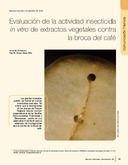| dc.contributor.author | Niño, J. | |
| dc.contributor.author | Lagos, A.M. | |
| dc.contributor.author | Mosquera, O.M. | |
| dc.date.accessioned | 2015-03-19T21:31:09Z | |
| dc.date.available | 2015-03-19T21:31:09Z | |
| dc.date.issued | 2009-12 | |
| dc.identifier.issn | e-ISSN: 1659-1216 | es_EN |
| dc.identifier.uri | https://repositorio.catie.ac.cr/handle/11554/6266 | |
| dc.description | 4 páginas, 2 ilustraciones, 1 tabulación, 23 referencias. | traciones |
| dc.description | 4 páginas, 2 ilustraciones, 1 tabulación, 23 referencias. | traciones |
| dc.description.abstract | The insecticidal activity against the coffee berry borer (Hypothenemus hampei) was evaluated for 16 binary mixtures composed by the methanol extract of Critoniella acuminata (Asteraceae) and 9-dichloromethane and 7-methanol extracts of plants. The species evaluated belong to the Apocynaceae, Asteraceae, Euphorbiaceae, Melastomataceae, Solanaceae, Ranunculaceae, Rubiaceae and Urticaceae families, and were collected in reserve zones of the Central Colombian Coffee Eco-region. The in vitro insecticidal activity was evaluated using as experimental unit an eppendorf tube, inside of which a coffee grain treated with each mixture at 1000 mg/L and an adult female coffee berry borer were placed. The binary mixtures of C. acuminata/ Tetrorchidium andinum and C. acuminata/Dunalia solanacea showed the highest in vitro insecticidal activities with values of 58% and 65%, respectively. These results show that plants from the Central Colombian Coffee Eco-region can be a potential source of new agents with insecticidal activity. | |
| dc.description.abstract | Con el fin de determinar la actividad insecticida de extractos de plantas contra la broca del café (Hypothenemus hampei), se evaluaron 16 mezclas binarias preparadas con el extracto metanólico de Critoniella acuminata (Asteraceae) con nueve extractos de diclorometano y siete de metanol. Las plantas evaluadas pertenecen a las familias Apocynaceae, Asteraceae, Euphorbiaceae, Melastomataceae, Solanaceae, Ranunculaceae, Rubiaceae y Urticaceae, y fueron recolectadas en zonas de reserva de la Ecorregión Cafetera Central de Colombia. La actividad insecticida in vitro se evaluó utilizando como unidad experimental un tubo eppendorf, dentro del cual se introdujo un grano de café pergamino impregnado con las mezclas a 1000 mg/L y una hembra de broca adulta. Las mezclas binarias de C. acuminata/Tetrorchidium andinum y C. acuminata/ Dunalia solanacea presentaron los mayores porcentajes de actividad insecticida in vitro, con valores del 58% y 65%, respectivamente. Estos resultados señalan que las plantas de la Ecorregión Cafetera Central Colombiana pueden ser una fuente potencial de nuevos agentes con actividad insecticida. | es_ES |
| dc.language.iso | es | es_ES |
| dc.publisher | CATIE, Turrialba (Costa Rica) | es_ES |
| dc.relation.ispartof | Recursos Naturales y Ambiente Número 58 (Diciembre 2009), páginas 40-44 | |
| dc.rights | info:eu-repo/semantics/openAccess | |
| dc.subject | APOCYNACEAE | |
| dc.subject | ASTERACEAE | |
| dc.subject | EUPHORBIACEAE | |
| dc.subject | MELASTOMATACEAE | |
| dc.subject | SOLANACEAE | |
| dc.subject | RANUNCULACEAE | |
| dc.subject | URTICACEAE | |
| dc.subject | INSECTICIDAS DE ORIGEN VEGETAL | |
| dc.subject | EXTRACTOS VEGETALES IN VITRO | |
| dc.subject | COLOMBIA | |
| dc.subject | HYPOTHENEMUS HAMPEI | es_ES |
| dc.title | Evaluación de la actividad insecticida in vitro de mezclas binarias de extractos vegetales contra la broca del café | es_ES |
| dc.title.alternative | Evaluation in vitro of the insecticidal activity of vegetal binary mixtures against the coffee berry borer | es_ES |
| dc.type | Artículo | es_ES |
| dc.journal.issueNumber | 58 | |


